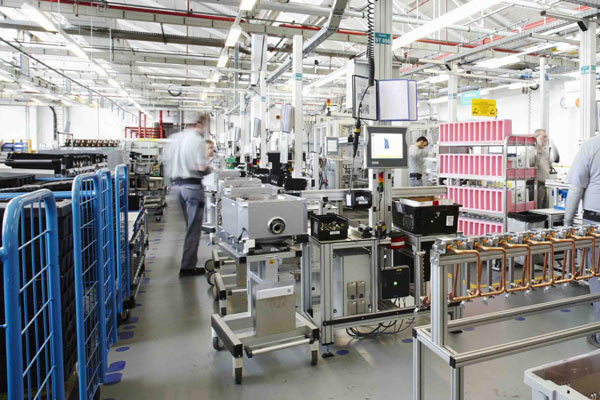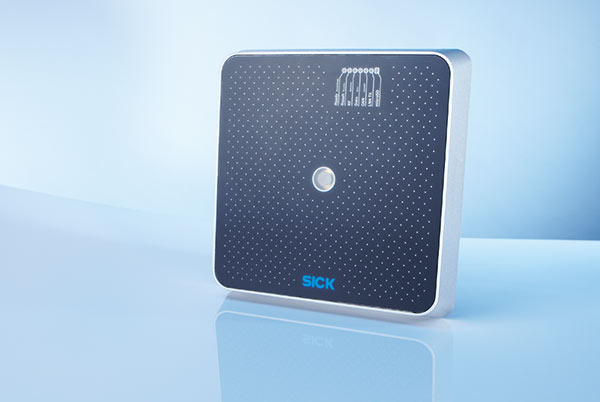Increasingly, global networks are replacing closed value-added chains. The goal here is to achieve the best possible efficiency over the entire production and distribution path by means of gap-free data transparency. This is possible by using RFID technology (RFID = radio-frequency identification), which is defining the current trends in contemporary factory and logistics automation. This is how it works: A memory chip that can be identified via radio frequency is attached to an object. The data on the chip can be output and rewritten as required.

Using RFID technology brings numerous benefits. It accelerates logistics processes and automates identification procedures. The result: A clear reduction in the manual workflow steps that were previously required. Data acquisition is carried out flawlessly and also enables additional data to be recorded. In short, this results in enhanced process transparency overall. In factory automation, the required data is stored remotely on the object itself and provides up-to-date information about the steps being performed in the current production flow. This allows an increase in the number of variants and facilitates flexible design of production processes.
Vaillant Group: Production process management and track and trace with RFID
The Vaillant Group is now using RFID technology for standardized final assembly of its heating technology products at its production sites, which are spread across five European countries and China.
RFU63x RFID read/write devices from SICK used for final assembly of the turboTEC/5

Final assembly of 16 variants and four different output versions (20, 24, 28, and 36 kW) of the turboTEC/5 non-condensing boiler for the Chinese market takes place on an assembly line in the Remscheid factory in Germany. RFU63x RFID read/write devices by SICK are used to continuously collect and read data during the final assembly process. When production begins, the unique identification code of the RFID tag attached to the assembly trolley is read and linked with the serial number of the item to be manufactured in a database. From this point onward, this combination of RFID code and serial number acts as a reference variable for controlling the assembly process. Thanks to automatic detection of the RFID code, it is possible to monitor the status of the process and access the relevant process parameters at any time, and the results gathered during the assembly process can easily be assigned to the product. The product to be manufactured follows its preset path through the manufacturing process using RFID technology from SICK. The person responsible on site receives clear information about the further processing of the component at each of the workstations along the assembly line. The line consists of several assembly and test stations. These include stations for screwing together the outer housing and the heating shaft, for assembling the hydraulic group and the cable harness, and for assembling the gas pipelines, burner, and switch cabinet. There are also a number of preassembly, testing, and calibration processes, as well as the packaging of the fully assembled devices. All of the process steps are standardized. The necessary steps in the workflow process are intuitively displayed to the worker on the workstation screens. Steps in the assembly process that need to be performed manually by the operator are supported by poka-yoke devices and pick-by-light systems. From the number and sequence of screws, the correct torque, and even the detection of component bar codes using hand-held scanners, a whole range of variant-dependent assembly sequences and the parameters for those sequences, as well as any results, are stored in a central database. Reliable identification of the transponder on the trolley provides information on which variant is awaiting assembly or testing and which of the numerous, variant-dependent assembly and testing sequences apply. This is done step by step, meaning the operators cannot miss anything out; nor can they repeat the same step twice. Once the assembly process has been successfully completed, the trolley is automatically registered as inactive, and is ready for the next assembly process. If a step in the assembly process has not been fully completed, the trolley will not be permitted to enter the next station. The assembly processes and communication with the RFID read/write device by SICK are managed and controlled using the AMS+ assembly management software, developed in-house by the Vaillant Group. Across all Vaillant Group factories, this software is used to control, configure, and monitor around 300 test benches and over 50 assembly lines online. All systems are connected via a central data storage system.
Connecting and forwarding data with the right Technology
The SICK system helps us to link up data and forward it from one station to the next, explains Christian Kron, Production Test Development Manager at the Vaillant Group. The company launched its project to improve the efficiency of its final assembly processes back in 2007, when the use of manual scanners to detect the trolley identification numbers required for process control and monitoring was leading to unacceptably long PSDI times, especially in the case of high-runner products, several hundreds of thousands of which are manufactured every year. Operators no longer need to pick up a scanner for identification, because they are automatically tracked throughout the process by the RFID technology. When operators arrive at the next workstation, they can immediately view information on the next step required in the working process. They can start work right away and are intuitively guided through the process. That is an improvement - without a doubt, explains Kron, highlighting the benefits of the RFID solution. When scanners are used, operators arrive at the station, pick up the scanner, perform the scan, and only then does the information they need appear on screen. Alongside the increased level of automation, the RFID system also contributes to improved process monitoring, which resulted in a zero error rate for A errors in the Remscheid factory last year.
Vaillants entire product range tracked throughout production using RFID technology from SICK
The Vaillant Group has now rolled out the RFID technology from SICK worldwide. We like the convenience of it, summarizes Kron. Also convenient is the fact that SICK has global radio equipment type approvals for the RFU63x RFID read/write devices. The Vaillant Group is now considering further applications using RFID in future, as there are plenty of other ways to make use of the transponders. On top of providing links between systems across all sites, from goods receipt to logistics, preventive maintenance and servicing are already available as an option in the self-developed AMS+ assembly management software. Increasing quality requirements and the desire for resource efficiency necessitate autonomous fault detection through comprehensive product and production data. In the area of quality control, goods in the production process and supply chain must be reliably and uniquely identifiable so that they can support efficient automated control.
Simple integration - intelligence included: RFU63x RFID read/write devices

The RFU63x by SICK marks the launch of a new generation of RFID read/write devices for UHF that are suitable for industrial use. Thanks to its smart process logic, the RFU63x provides an autonomous solution for applications in the production, logistics, and traffic sectors. It can also be used as a stand-alone system. Integrated functions such as data processing and filtering ensure an optimum and stable reading performance. SICKs 4Dpro technology allows the RFU63x to be easily and economically integrated into all major industrial networks. Parameters can be transferred to other devices via microSD memory cards using the cloning backup system. This significantly reduces the time required for replacing and setting up devices. A freely configurable LED signal can provide the user with additional information on, for example, read results or diagnostics data. The SOPAS configuration tool is used for configuration, and application-specific software can be integrated into the RFU63x. Up to three external antennas can be connected on top of the integrated antenna, and switching inputs, for connecting a trigger photoelectric sensor, for example, can be flexibly configured in order to control certain actions. Moreover, unrestricted outputs can be used to display read results or to control actuators, for example. As the RFU63x works with 4Dpro technology, it provides a whole range of integrated interfaces for connecting to host systems such as Ethernet, RS-232, RS-422, RS-485, CAN, CANopen, etc. In addition, SICKs developers have also taken into account system configuration or diagnostics via Ethernet, RS-232, or USB, for example. Non-integrated fieldbuses such as PROFIBUS or EtherCAT® can be addressed via external gateways, and function blocks are also available in the RFU63x for facilitating integration into these fieldbuses. For the purposes of completing typical tasks, the RFU63x has a smart set of useful, integrated functions for data filtering and processing, making it much easier to adapt the device to common tasks.
Modular and future-proof
Due to its modular design, the RFU63x can be used flexibly and at minimal expense, and thanks to its 4Dpro compatibility, it can also be used in combination with neighboring technologies. This means standard accessories can be used across all of the different technologies, while transponders can be selected in accordance with the application in question. In addition, firmware updates allow the system to adapt to future developments, ensuring a high level of investment security. The high impetus in global markets produces an ever-increasing competitive pressure. More stringent standards, shorter and shorter product life cycles, and individual customer requests place high demands on data transparency within a company. Communication via RFID devices and remote intelligence are the foundations needed to increase efficiency in production and logistics, improve the monitoring and management of processes, and thus improve transparency. Under Industry 4.0, we will see new intelligent networking of factories. This will help us to achieve the level of flexibility needed in logistics processes, both within a single factory and across an entire chain of production sites. As a result, we will be able to bridge the gap between productivity and the demand for customized solutions. Intelligent sensor technology plays a key role in this trend: Sensors from SICK are able to detect objects and conditions, providing users with a wealth of data. Our sensors computing power and intelligence make it possible to trace relationships between all of this data. They increase transparency, which in turn forms the basis for improving flexibility.
- Product informationen: RFU63x
- Product portfolio: Radio-Frequenz-Identifikation
- More information: Vaillant

